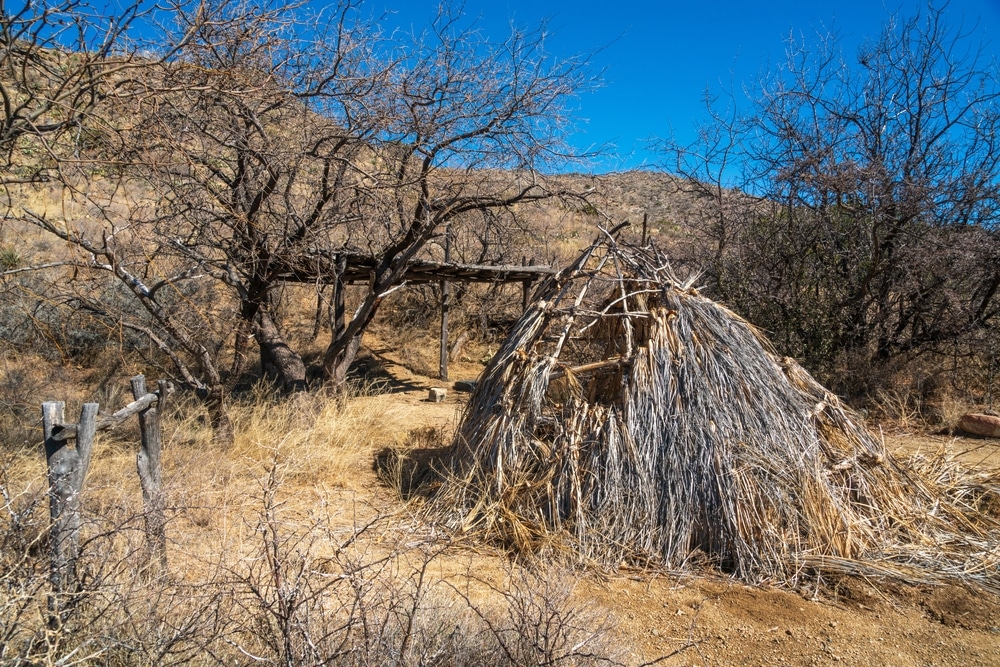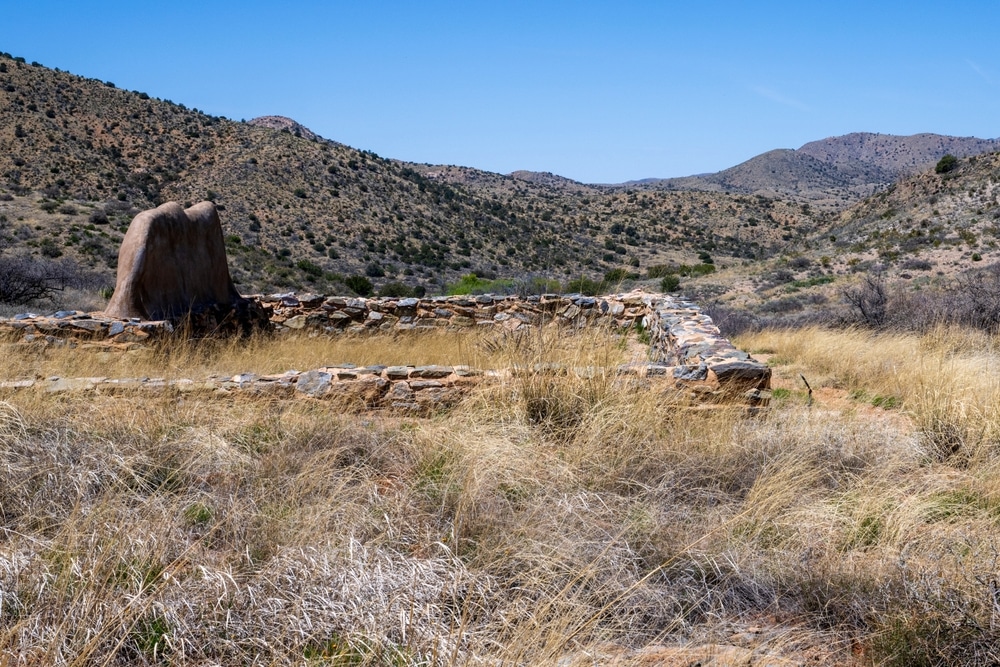Nestled within the rugged landscape of southeastern Arizona, Fort Bowie National Historic Site stands as a poignant reminder of a pivotal chapter in American history. For nearly 25 years, this military outpost served as the epicenter of conflict between the U.S. Army’s westward expansion and the Chiricahua Apache’s determined defense of their ancestral homeland. Today, the site preserves not only the physical remains of the fort but also the complex narrative of cultural collision that forever altered the course of both American and Indigenous history.
Fort Bowie represents one of Arizona’s most historically significant yet least visited national historic sites, offering visitors a unique opportunity to experience history in an intimate setting far from the crowds of more popular destinations. The site’s remote location and access requirements create an immersive journey that connects visitors to the challenging conditions faced by both soldiers and Apache people during the late 19th century.
Established in 1862 and declared a National Historic Landmark in 1960, Fort Bowie provides a window into the Apache Wars, a series of conflicts that culminated in the surrender of the legendary Apache leader Geronimo in 1886. This guide aims to provide comprehensive information about Fort Bowie’s historical significance, recreational opportunities, and practical visitor information to enhance your experience at this remarkable historic site.

The ruins of Fort Bowie are the centerpiece of the site. Visitors can explore:
Walking through these ruins provides a glimpse into what life was like for soldiers stationed in this remote and rugged environment.
The Fort Bowie Visitor Center, located near the ruins, offers:

The Fort Bowie Historic Trail is the primary way to access the ruins of the fort and immerse yourself in the historical and natural beauty of the area. The 1.5-mile trail (3 miles round-trip) takes you through:
The hike is moderately strenuous, so bring plenty of water, wear sturdy shoes, and enjoy the interpretive signs that provide insight into the area’s history.

Fort Bowie was established during the Apache Wars, a decades-long conflict between the U.S. government and the Chiricahua Apache tribe. Visitors can learn about key events, such as:
The interpretive signage and exhibits at the site provide a deeper understanding of these historical events.

The area around Fort Bowie offers peaceful spots for a picnic. After exploring the ruins and hiking the trail, relax in the shade of cottonwood trees or near the visitor center while enjoying your meal. Be sure to pack all trash out to preserve the natural beauty of the site.

Fort Bowie’s blend of history and natural beauty makes it a great spot for photography. Capture:
Sunrise and sunset are particularly magical times to photograph the site, with soft light enhancing the colors of the desert.

The natural environment around Fort Bowie is home to a variety of wildlife, making it a great destination for nature lovers. Keep an eye out for:
Bring binoculars for better wildlife viewing.

| Category | Details |
|---|---|
| Location | Cochise County, southeastern Arizona, USA |
| Established | 1862 |
| Abandoned | 1894 |
| Managed by | National Park Service (NPS) |
| Designation | Fort Bowie National Historic Site (designated in 1964) |
| Area | Approximately 999 acres |
| Purpose | Originally established during the Apache Wars to protect settlers and secure Apache Pass, a key transportation route |
| Historical Significance | Site of the Battle of Apache Pass (1862) and a key location during conflicts between the U.S. Army and the Chiricahua Apache, including figures like Cochise and Geronimo |
| Nearest City | Bowie, Arizona |
| Features | Ruins of the fort, cemetery, Apache Spring, and interpretive trails |
| Activities | Hiking, historical tours, wildlife viewing, and photography |
| Access | Accessible by a 3-mile round-trip hike via the main trailhead; no direct vehicle access to the fort |
| Wildlife | Mule deer, javelinas, coyotes, lizards, and bird species like hawks and hummingbirds |
| Vegetation | Mesquite trees, desert grasses, cacti, and wildflowers |
| Climate | Semi-arid with hot summers, mild winters, and seasonal monsoon rains |
| Visitor Center | Located near the trailhead; offers exhibits and information about the site’s history |
| Significance | Preserves the legacy of the Apache Wars and the cultural interactions between Native Americans and settlers |
| Website | National Park Service – Fort Bowie |
Fort Huachuca was established in 1877 as a camp during the Apache Wars, specifically to counter the Chiricahua Apache threat and secure the border with Mexico. Named after the nearby Huachuca Mountains (the name “Huachuca” is believed to be derived from an Apache word meaning “thunder” or “place of thunder”), the post played a crucial role in the frontier era of the American Southwest.
The fort’s strategic location provided military forces with a vantage point to monitor movements along the U.S.-Mexico border and throughout the surrounding valleys. After the surrender of the Apache leader Geronimo in 1886, the fort continued to serve as an important border outpost.
From 1913 to 1933, Fort Huachuca was home to the famous “Buffalo Soldiers” of the 10th Cavalry Regiment. These African American regiments were among the most decorated units in U.S. military history, and their presence at Fort Huachuca represents an important chapter in both military history and African American history. The contributions of the Buffalo Soldiers are commemorated today in various historical exhibits and markers throughout the fort.
During World War II, Fort Huachuca underwent a massive expansion, with the post growing to accommodate quarters for more than 25,000 male soldiers and hundreds of Women’s Army Corps (WAC) members. The 92nd and 93rd Infantry Divisions, composed of African American troops, trained at Fort Huachuca during this period.
After a brief closure following World War II, the fort was reopened in 1951 during the Korean War. In subsequent decades, Fort Huachuca became increasingly focused on intelligence and communications, eventually becoming the headquarters for the U.S. Army Intelligence Center and the Network Enterprise Technology Command.
Today, Fort Huachuca continues to serve as an active military installation while also providing recreational opportunities that capitalize on its unique environment and rich history.
Access to Fort Huachuca and its recreational facilities is primarily available to:
Civilian visitors without Department of Defense identification cards must pass a criminal background check before being allowed to enter the fort. This security procedure is typically conducted at the main gate and requires a valid government-issued photo ID.
Visitors can enter Fort Huachuca through several access points, with the Main Gate (Buffalo Soldier Gate) on Hatfield Street being the primary entrance. The East Gate off State Route 90 provides an alternative entry point.
All visitors must present valid identification at the gate:
Visitors should be aware that as an active military installation, Fort Huachuca maintains security protocols that may include vehicle inspections and restricted access to certain areas. Photography may also be restricted in some areas of the fort.
One of the premier recreational facilities at Fort Huachuca is the Apache Flats RV Resort, a nationally recognized RV park offering a comfortable base from which to explore the area. The resort features:
The resort is particularly popular during winter months, when visitors come to enjoy Arizona’s mild climate. Reservations are required and can be made up to 90 days in advance. The maximum stay is limited to 60 days from November 1 to April 29, and 90 days from April 30 to September 30.
Apache Flats RV Resort is restricted to recreational vehicles certified by the Recreation Vehicle Industry Association (RVIA) and is not suitable for tent camping or non-certified vehicles.
For those seeking a smaller, more rustic RV experience, Garden Canyon RV Park offers:
Like Apache Flats, Garden Canyon RV Park is designed for RVIA-certified vehicles and does not accommodate tent camping.
For those who prefer a more primitive camping experience, Fort Huachuca offers remote camping opportunities in designated areas. These sites are typically located in scenic canyon areas and provide a more immersive natural experience. Permits and reservations may be required for remote camping locations.
Fort Huachuca features Lakeside Pavilions with picnic sites perfect for day use. These areas provide:
Reservations for pavilions can be made through the Fort Huachuca Outdoor Recreation office, with prices ranging from $40 to $140 per day depending on the size and amenities of the pavilion.
Lower Garden Canyon offers both camping and picnic areas for visitors. This scenic canyon provides:
The canyon is particularly known for its biodiversity and is a favorite spot for nature enthusiasts.
Fort Huachuca boasts an extensive network of hiking trails that traverse diverse terrain and offer spectacular views of the surrounding mountains and valleys. Some notable trails include:
Sawmill Trail: A popular 3.9-mile trail with an elevation gain of 758 feet, offering beautiful views and a moderate challenge for hikers of various skill levels.
Huachuca Canyon Trail: This trail runs parallel to Huachuca Canyon Road for about two miles before connecting with additional trails. It features steep sections with significant elevation gain and rewards hikers with panoramic views.
McClure Canyon Trail: Primarily used for off-highway vehicles but also open to hiking, this trail offers a more rugged experience for adventurous hikers.
Trails at Fort Huachuca vary in difficulty from easy walks suitable for families to challenging routes that appeal to experienced hikers. Many trails offer opportunities to observe local wildlife and native plant species.
Hikers should note that some areas within Fort Huachuca are used for military maneuvers and may be off-limits. Always respect posted boundaries and restrictions.
The Buffalo Corral Riding Stables, located in the scenic foothills of Fort Huachuca, offers a range of equestrian activities:
The stables provide an opportunity to explore Fort Huachuca’s beautiful terrain on horseback, with trails winding through diverse landscapes and offering views of the surrounding mountains and valleys.
Ghost Town Paintball offers an exciting recreational option for those seeking more adrenaline-fueled activities. The facility features:
The Ghost Town Paintball area is designed to accommodate players of different experience levels and provides a safe environment for this popular sport.
The diverse ecosystems within Fort Huachuca make it an excellent destination for wildlife viewing and nature photography. The fort is located in an area known for its biodiversity, including:
Garden Canyon and Huachuca Canyon are particularly known for their wildlife viewing opportunities, with the riparian areas attracting a variety of species. Dawn and dusk are typically the best times for wildlife observation.
Fort Huachuca offers the Warrior Adventure Quest (WAQ) program, designed primarily as a training tool for soldiers returning from deployment. This program combines outdoor recreation with therapeutic benefits, helping service members adjust to post-deployment life through challenging and engaging activities.
WAQ activities available at Fort Huachuca include:
While primarily designed for military personnel, some WAQ activities may be available to other eligible visitors during specific times.
The Barnes Field House serves as the main fitness center at Fort Huachuca, offering:
The facility is open to authorized personnel and provides a comprehensive fitness experience with professional staff available to assist with training and equipment use.
Mountain View Golf Course offers a scenic golfing experience with views of the Huachuca Mountains. The course features:
The course is open to authorized personnel and their guests, with special rates available for active duty military, retirees, and Department of Defense civilians.
Fort Huachuca maintains various sports fields and courts for both organized leagues and casual use:
These facilities support both unit physical training and recreational sports activities, with leagues and tournaments organized throughout the year.
The Fort Huachuca Museum preserves and interprets the history of the fort and the U.S. Army in the Southwest. The museum features:
The museum is open to all visitors, including civilians without military identification, though they must pass a background check to enter the fort. Admission to the museum is free of charge.
The U.S. Army Intelligence Museum showcases the history and evolution of military intelligence operations and technology. Exhibits cover:
Like the Fort Huachuca Museum, the Intelligence Museum is accessible to authorized visitors and provides valuable insights into this specialized field of military operations.
Bordering Fort Huachuca, the Coronado National Forest offers additional recreational opportunities, including:
The forest encompasses several mountain ranges, providing diverse ecosystems and recreational environments within a short drive of Fort Huachuca.
Located approximately an hour’s drive from Fort Huachuca, Patagonia Lake State Park features:
The park is particularly known for its fishing, with species including bass, crappie, bluegill, and catfish, and trout stocked regularly during cooler months.
Roper Lake State Park, located near Safford, Arizona, offers:
The park’s natural hot springs are a particular draw, providing a relaxing experience after a day of hiking or exploring.
The adjacent city of Sierra Vista provides additional amenities and attractions:
Sierra Vista serves as a convenient hub for supplies, services, and urban amenities to complement the recreational experiences available at Fort Huachuca.
Operating hours vary by facility:
Apache Flats RV Resort and Garden Canyon RV Park: Office typically open 8:00 AM to 4:00 PM daily, with after-hours check-in available for those with reservations.
Fort Huachuca Museum: Generally open Tuesday through Saturday, 9:00 AM to 4:00 PM, closed on federal holidays.
Outdoor Recreation Office: Monday through Friday, 8:00 AM to 4:00 PM, with limited weekend hours for equipment rental.
Buffalo Corral Riding Stables: Thursday through Sunday, with hours varying seasonally.
Always check current operating hours before planning your visit, as schedules may change based on military operations, seasonal factors, or staffing availability.
Most recreational facilities at Fort Huachuca require reservations:
Apache Flats RV Resort: Reservations can be made up to 90 days in advance by calling (520) 533-1335. Rates are approximately $35 per day or $625 for 30 days.
Garden Canyon RV Park: Reservations recommended, especially during peak season.
Lakeside Pavilions and Picnic Areas: Reservations required for group use, with fees ranging from $40 to $140 depending on the facility.
Buffalo Corral Riding Stables: Advance reservations recommended for trail rides and lessons by calling (520) 533-5220.
Payment is typically due at the time of check-in or service, with various payment methods accepted including credit cards at most facilities.
Fort Huachuca experiences a high desert climate with distinct seasonal variations:
Spring (March-May): Mild temperatures with occasional wind. Wildflowers may bloom following winter rains, making this an excellent time for hiking and photography.
Summer (June-September): Hot daytime temperatures, often exceeding 90°F (32°C), with cooler evenings. Afternoon thunderstorms are common during the monsoon season (July-September), which can create flash flood risks in canyon areas.
Fall (September-November): Gradually cooling temperatures with clear skies, making this one of the most pleasant seasons for outdoor activities.
Winter (December-February): Mild daytime temperatures averaging 60-65°F (15-18°C) with cold nights that can drop below freezing. Occasional light snow is possible at higher elevations but typically melts quickly.
Visitors should prepare for significant temperature variations between day and night throughout the year, and always carry adequate water for outdoor activities regardless of season.
When enjoying Fort Huachuca’s recreational areas, keep these safety considerations in mind:
Wildlife Awareness: The area is home to various wildlife, including snakes and other potentially dangerous species. Stay on designated trails, be aware of your surroundings, and know how to respond to wildlife encounters.
Flash Flood Risk: Canyon areas can experience sudden flash floods, especially during monsoon season. Avoid narrow canyons during rain or when storms are forecast.
Heat Safety: Summer temperatures can be extreme. Carry plenty of water, use sun protection, plan strenuous activities for cooler morning hours, and know the signs of heat-related illness.
Military Operations: Respect all posted signs and boundaries. Some areas may be temporarily closed for military training or operations.
Communication: Cell phone coverage can be limited in remote areas of the fort. Consider carrying alternative communication devices for emergencies.
Fire Safety: Observe all fire restrictions, which may vary seasonally. Completely extinguish any permitted fires and use only designated fire rings or grills.
Fort Huachuca places significant emphasis on environmental conservation and stewardship, recognizing the unique ecological value of its lands. The fort is part of the Fort Huachuca Sentinel Landscape Partnership, which works to promote land conservation, environmental resilience, and military mission protection.
The diverse ecosystems within Fort Huachuca support numerous plant and animal species, including some that are rare or endangered. Visitors are encouraged to practice Leave No Trace principles:
By following these principles, visitors help preserve the natural and cultural resources of Fort Huachuca for future generations.
Fort Huachuca Recreation Area offers a unique combination of military heritage, natural beauty, and recreational opportunities that make it a distinctive destination in southeastern Arizona. From its historic museums to its modern RV resort, from challenging hiking trails to scenic horseback riding routes, the fort provides diverse experiences for military personnel, their families, and eligible visitors.
The fort’s location in the foothills of the Huachuca Mountains, with its remarkable biodiversity and scenic landscapes, creates an ideal setting for outdoor recreation throughout the year. Meanwhile, its rich military history, preserved and interpreted through museums and historic sites, offers visitors the opportunity to connect with an important chapter in America’s past.
Whether you’re seeking active outdoor adventures, relaxing natural surroundings, or educational experiences, Fort Huachuca Recreation Area invites you to explore its many facets while respecting its dual role as both a military installation and a steward of valuable natural and cultural resources.
As you plan your visit to Fort Huachuca, remember that access procedures and reservation requirements are in place to ensure both security and a quality experience for all visitors. With proper preparation and respect for the fort’s regulations and natural environment, your time at Fort Huachuca Recreation Area can provide memorable experiences and a deeper appreciation for this special corner of Arizona.
We use cookies to improve your experience on our site. By using our site, you consent to cookies.
Manage your cookie preferences below:
Essential cookies enable basic functions and are necessary for the proper function of the website.
Statistics cookies collect information anonymously. This information helps us understand how visitors use our website.
Marketing cookies are used to follow visitors to websites. The intention is to show ads that are relevant and engaging to the individual user.